On March 26, 1947 all crew members survived as the XB-36 prototype bomber, built at and flown from Fort Worth, took the longest flight of its young life, circling over west Fort Worth for six hours to burn fuel before attempting to land with a damaged landing gear. Two and a half years later, on September 15, 1949, five B-36B crew members died in one of the shortest B-36 flights as the bomber crashed into Lake Worth moments after leaving the runway at Carswell Air Force Base.
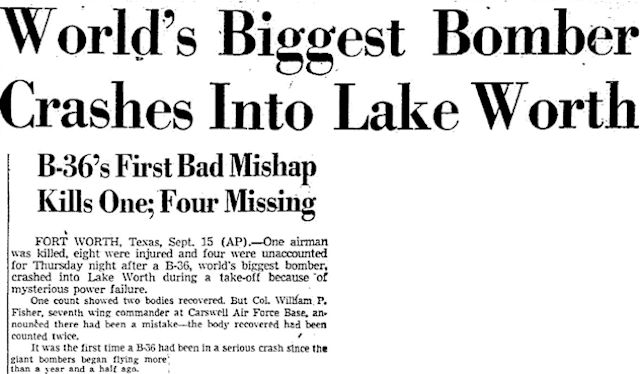 Carswell officials said the B-36 was starting a routine training flight about 7:35 p.m. The plane’s pilot, Troy Husband, later said, “During our takeoff run we were airborne for a few seconds. I don’t think we got more than five or ten feet in the air. . . . Then the plane settled down again. I saw we were running out of runway and were going to crash. I tried to apply the brakes and reverse the props. I don’t know if we got them reversed or not—we were at the end of the runway when we tried. There was a big jar when we hit [the water].” Clip is from the September 16 Dallas Morning News.
Carswell officials said the B-36 was starting a routine training flight about 7:35 p.m. The plane’s pilot, Troy Husband, later said, “During our takeoff run we were airborne for a few seconds. I don’t think we got more than five or ten feet in the air. . . . Then the plane settled down again. I saw we were running out of runway and were going to crash. I tried to apply the brakes and reverse the props. I don’t know if we got them reversed or not—we were at the end of the runway when we tried. There was a big jar when we hit [the water].” Clip is from the September 16 Dallas Morning News.
 The plane’s speed broke about halfway down the runway while traveling at about one hundred miles per hour. With insufficient speed to lift its 160,000 pounds, the plane rose only briefly off the runway before splashing into the lake in twenty-five feet of water approximately six hundred feet from the end of the runway. Headline is from the September 16 Fort Worth Press.
The plane’s speed broke about halfway down the runway while traveling at about one hundred miles per hour. With insufficient speed to lift its 160,000 pounds, the plane rose only briefly off the runway before splashing into the lake in twenty-five feet of water approximately six hundred feet from the end of the runway. Headline is from the September 16 Fort Worth Press.
J. M. Crump witnessed the crash as he fished on the dock of his home on the lake. Crump said he heard “an awful noise at first and then a streak of flame shot out behind the big ship. It was scarcely off the runway when it happened. It slid off the runway and into the water. There wasn’t any nosedive. After it came to rest it settled into the water, and we couldn’t see anything but its bulk in outline.”
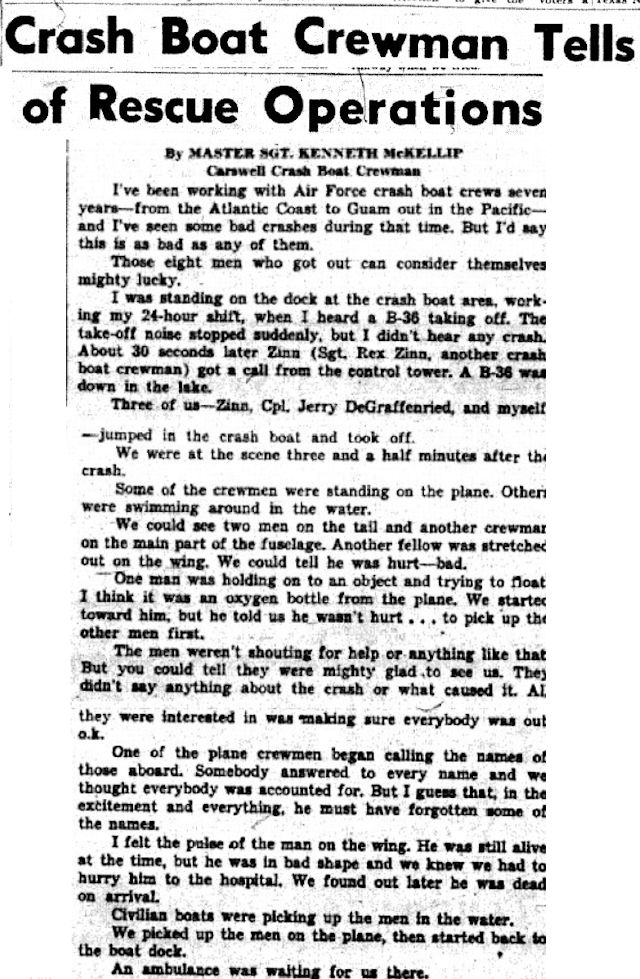 Clip is from the September 16 Press.
Clip is from the September 16 Press.
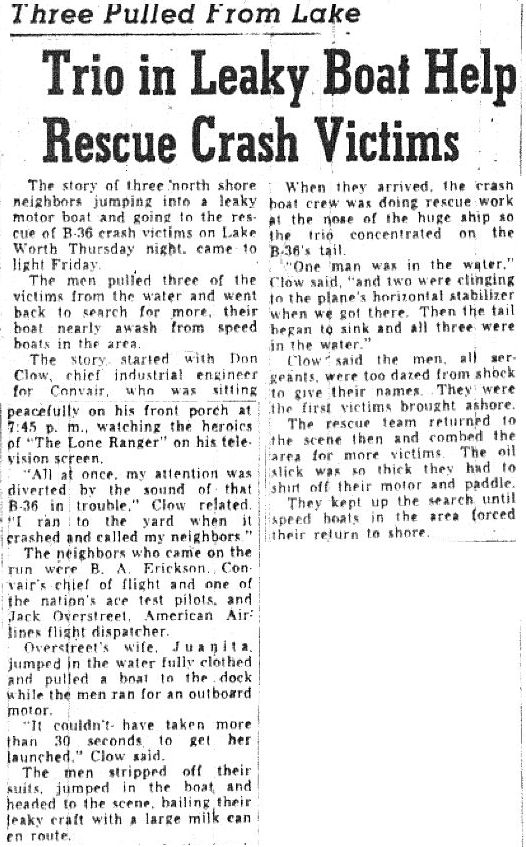 Among those people on shore who came to the rescue of crewmen was Beryl A. Erickson, the Convair (bomber plant) test pilot who had landed the damaged XB-36 in 1947. Clip is from the September 17 Star-Telegram.
Among those people on shore who came to the rescue of crewmen was Beryl A. Erickson, the Convair (bomber plant) test pilot who had landed the damaged XB-36 in 1947. Clip is from the September 17 Star-Telegram.
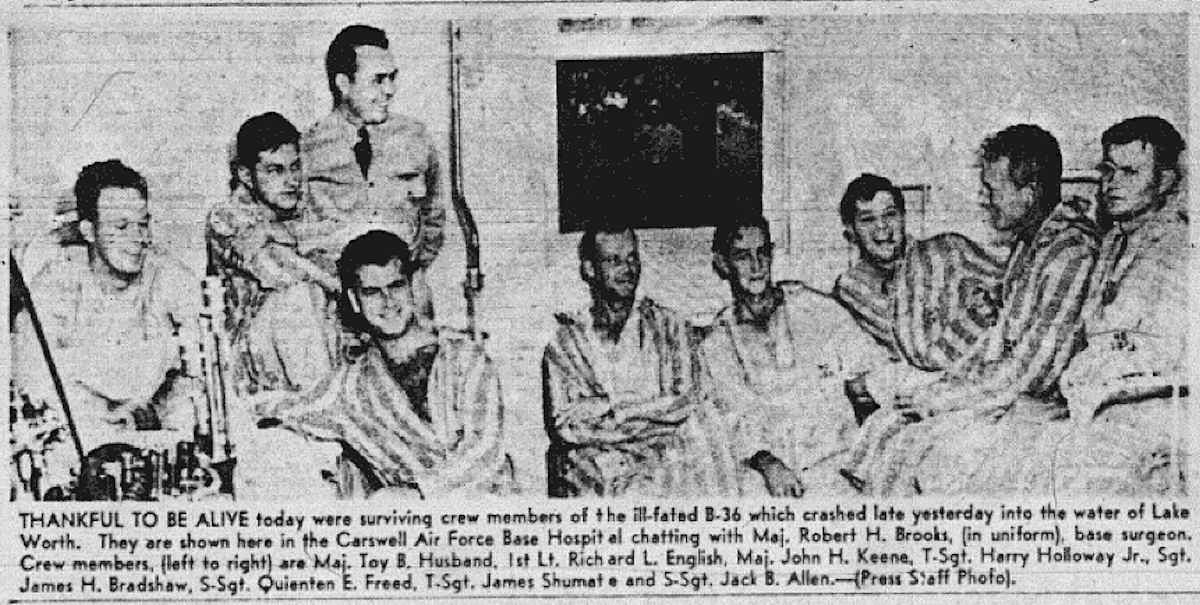 The plane carried only fifteen thousand gallons of aviation fuel, compared with a normal load of twenty-two thousand gallons. The lighter load probably allowed the plane to float briefly, allowing eight crewmen to escape. Photo is from the September 16 Press.
The plane carried only fifteen thousand gallons of aviation fuel, compared with a normal load of twenty-two thousand gallons. The lighter load probably allowed the plane to float briefly, allowing eight crewmen to escape. Photo is from the September 16 Press.
 But one crewman was killed upon impact with the water. Four others drowned. Clip is from the September 16 Press.
But one crewman was killed upon impact with the water. Four others drowned. Clip is from the September 16 Press.
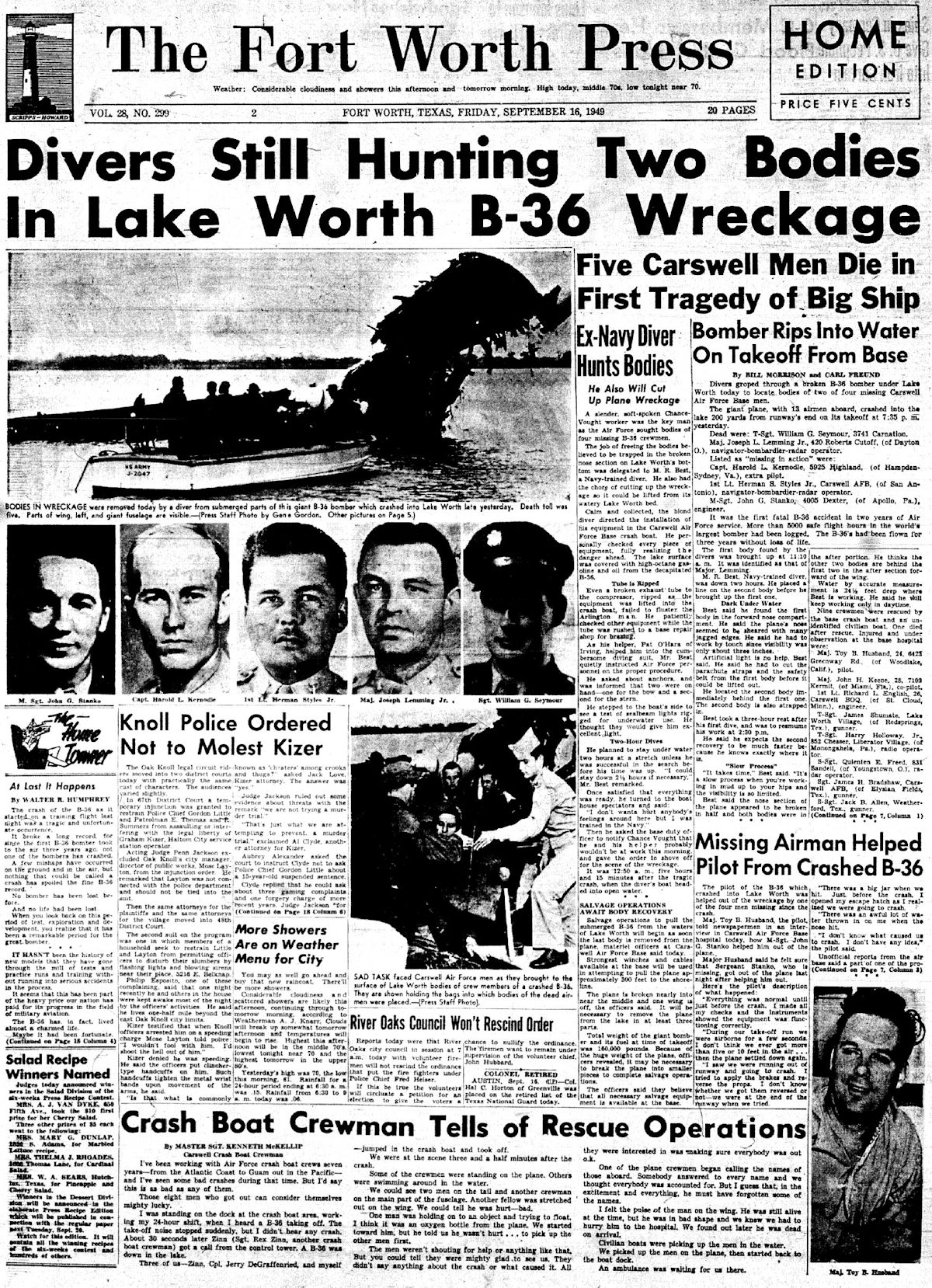 Front page of the Press on September 16.
Front page of the Press on September 16.
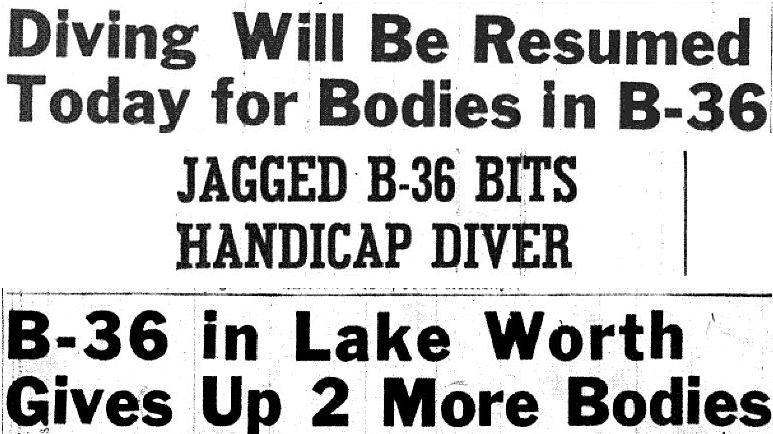 Recovery of the dead crewmen in the lake was slow. These headlines are from the September 17, 18, and 19 Star-Telegram.
Recovery of the dead crewmen in the lake was slow. These headlines are from the September 17, 18, and 19 Star-Telegram.
Likewise, removing the wreckage from the silty lake was a mammoth undertaking, but eventually Navy divers and Air Force salvage crewmen towed most of the tons of debris out of the lake.
 When writing about the giant bomber, writers could not resist ticking off the B-36’s vital statistics as if it were a beauty queen: The wing span (230 feet) was longer than the distance of the first Wright brothers flight in 1903. (This Lockheed Martin Aeronautics photo shows a B-25 medium bomber dwarfed by two B-36s.) The B-36’s bomb bay area was equivalent to four railroad box cars. Thirty miles of wiring. Fuel capacity sufficient to take a motorist around the world eighteen times. Total engine power equal to that of nine locomotives. Maximum bomb payload of eighty-four thousand pounds. Propellers nineteen feet in diameter. The top of a B-36’s tail was forty-seven feet off the ground.
When writing about the giant bomber, writers could not resist ticking off the B-36’s vital statistics as if it were a beauty queen: The wing span (230 feet) was longer than the distance of the first Wright brothers flight in 1903. (This Lockheed Martin Aeronautics photo shows a B-25 medium bomber dwarfed by two B-36s.) The B-36’s bomb bay area was equivalent to four railroad box cars. Thirty miles of wiring. Fuel capacity sufficient to take a motorist around the world eighteen times. Total engine power equal to that of nine locomotives. Maximum bomb payload of eighty-four thousand pounds. Propellers nineteen feet in diameter. The top of a B-36’s tail was forty-seven feet off the ground.
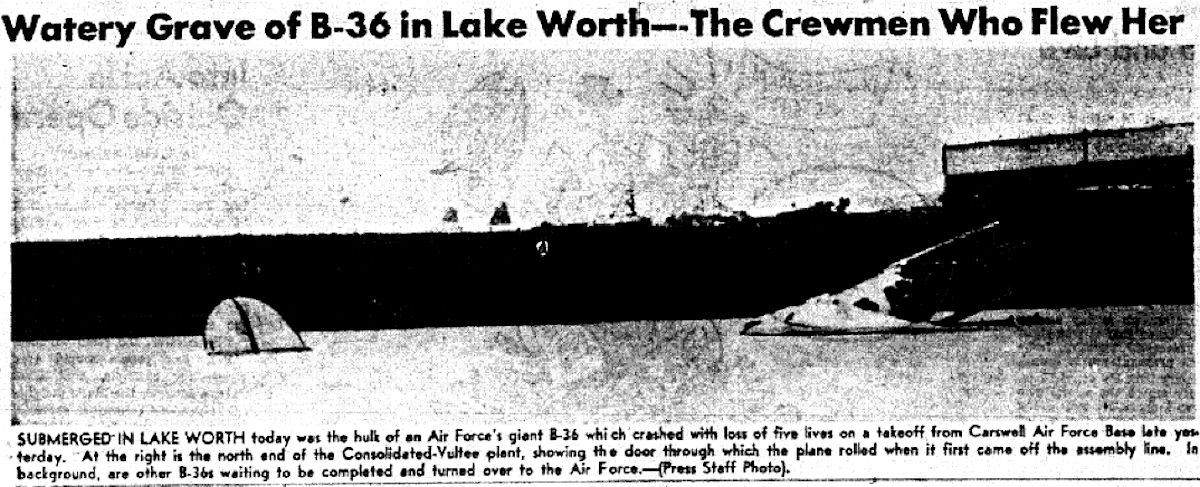 But, as this photo in the September 16 Press shows, only a few feet of that forty-seven-foot-tall tail was visible in Lake Worth after the crash. The .9-mile-long bomber plant assembly building can be seen on the right.
But, as this photo in the September 16 Press shows, only a few feet of that forty-seven-foot-tall tail was visible in Lake Worth after the crash. The .9-mile-long bomber plant assembly building can be seen on the right.
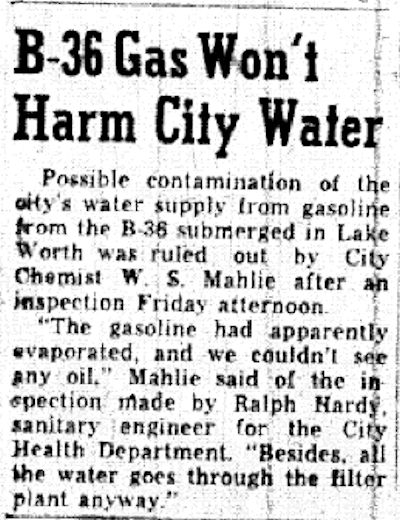 Despite the fact that witnesses saw aviation fuel and oil on the surface of the lake, the water department assured residents that Lake Worth water was safe to drink.
Despite the fact that witnesses saw aviation fuel and oil on the surface of the lake, the water department assured residents that Lake Worth water was safe to drink.
 Reports from surviving crewmen indicated that the bomber probably crashed because two props reversed their pitch during takeoff, causing a braking effect on the plane’s left side. Investigators doubted this theory of reversed thrust until two props on another B-36 later reversed thrust as the plane landed at Carswell. The two incidents led to establishment of a safety check in which crewmen personally confirmed thrust direction before takeoff. Later lights were installed in the cockpit to indicate thrust direction of the props.
Reports from surviving crewmen indicated that the bomber probably crashed because two props reversed their pitch during takeoff, causing a braking effect on the plane’s left side. Investigators doubted this theory of reversed thrust until two props on another B-36 later reversed thrust as the plane landed at Carswell. The two incidents led to establishment of a safety check in which crewmen personally confirmed thrust direction before takeoff. Later lights were installed in the cockpit to indicate thrust direction of the props.
Four jet engines were added to later B-36s to increase thrust. The combination of six prop engines and four jet engines was referred to as “six turning and four burning.” (Photo from Lockheed Martin Aeronautics Company.)
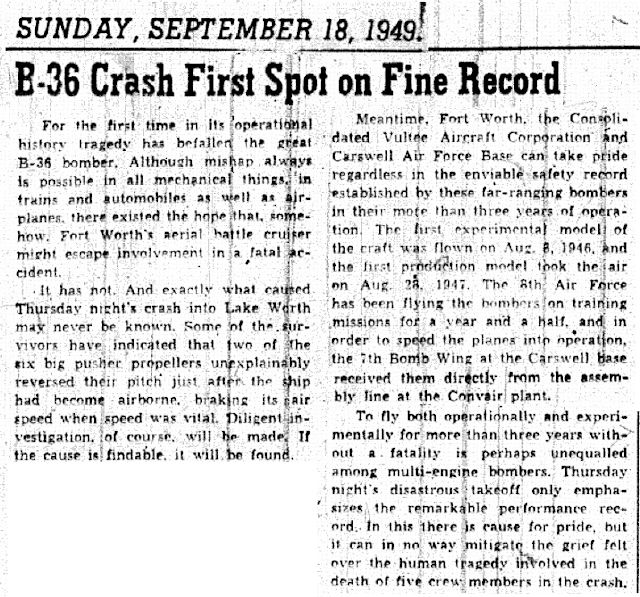 Editorial is from the Star-Telegram. Major General Roger M. Ramey, 8th Air Force commanding officer, said that the crash was the first in two years (five thousand flight hours) of 8th Air Force B-36 flying and that “accidents will happen as long as we operate machinery, whether it be roller skates or aircraft.”
Editorial is from the Star-Telegram. Major General Roger M. Ramey, 8th Air Force commanding officer, said that the crash was the first in two years (five thousand flight hours) of 8th Air Force B-36 flying and that “accidents will happen as long as we operate machinery, whether it be roller skates or aircraft.”
Today only four of the 383 B-36s built by Convair survive. None is airworthy.
KERA video (no audio):






Thanks for this information. I am the nephew of Capt. Harold Kernodle. My Mom and her family talked about this terible tragedy all of my lifetime so I decided to see what information was out there related to the accident. Finding this site was invaluable!!
Thank you for sharing this information. Sgt. William G. Seymour was my great uncle. I appreciate being able to learn more about this piece of my family’s history.
I believe there was also an F-4 that went down there. The Point has a photo up in the bay for years of the barge pulling it out of the water.
I was hoping the remains of the plane is still visible in Lake Worth. I guess not.
I want to thank you for such a wonderful collection of historical memorabilia having to do with the
B-36 Bomber incident In Lake Worth. I wound up here researching a Consolidated Vultee Aircraft
B-24,PBY,B-36 Control Wheel Yoke Cap Emblem Badge (searchable) I have of which I knew nothing about. Once I figured out what I had and it’s value the rest was pretty easy and provided me an answer to a long time curiosity I had. I was raised in White Settlement from 1957 on via my dad of course and his flight line job at Convair,General Dynamics, Lockeed Martin and we always had the greatest air shows ever and still do. I never took the time to get the whole story about the B-36 incident, I only got the word of mouth story and there was a lot of mouth in W.S. Anyway I am so glad this is where I wound up and I appreciate the History you have provided here it was Well Worth The Read! Thank You-Gerald
Thanks, Gerald. It has been interesting to learn the history of those behemoths we used to first hear and then see overhead as I was growing up.
There is one on display at the Castle AFB Museum near Merced CA.
Wish Fort Worth had held on to its B-36 on static display. And its steam locomotive.
Another well-preserved example is at the Air Force museum in Dayton, Ohio.